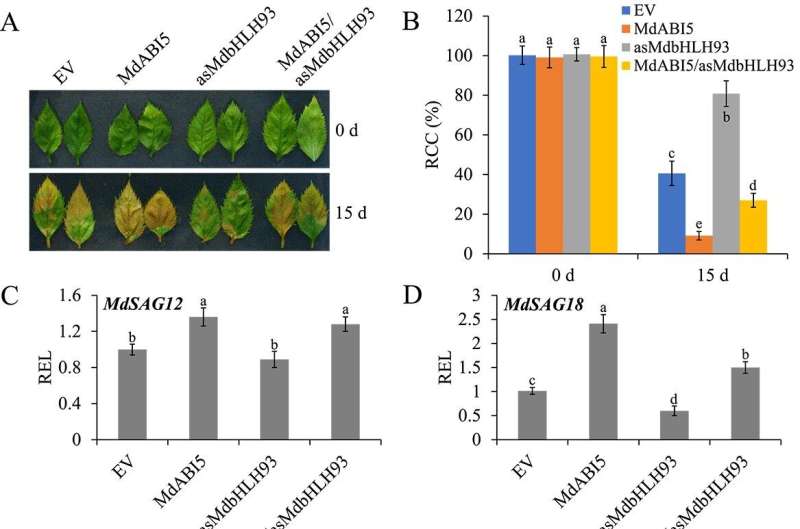This article has been reviewed according to Science X's editorial process and policies. Editors have highlighted the following attributes while ensuring the content's credibility:
fact-checked
peer-reviewed publication
trusted source
proofread
Fountain of youth for plants: E3 ligase's role in leaf longevity

A recent study uncovers the intricate molecular mechanisms that regulate leaf senescence in apple plants, focusing on the crucial role of the E3 ligase enzyme, MdPUB23, and its interaction with the ABI5 protein. This research provides valuable insights into how plants manage stress responses and maintain growth, offering potential applications in improving crop yield and stress resistance.
Leaf senescence is a vital phase in the life cycle of plants, impacting overall plant health and yield. Abscisic acid (ABA) is a plant hormone that accelerates leaf senescence in response to environmental stress. However, the precise regulatory mechanisms of ABA-triggered leaf senescence are not fully understood. Due to these challenges, there is a need for in-depth research to explore the molecular pathways involved.
Researchers from Shandong Agricultural University and Yantai Academy of Agricultural Sciences conducted a study published on January 30, 2024, in Horticulture Research, investigating the role of MdPUB23, an E3 ubiquitin ligase, in ABA-induced leaf senescence in apple plants. The findings revealed that MdPUB23 interacts with the ABI5 protein, promoting its degradation and thereby delaying the senescence process.
The study examined the interaction between MdPUB23 and ABI5, a key regulatory protein in the ABA signaling pathway. Through experiments including yeast two-hybrid assays, pull-down assays, and bimolecular fluorescence complementation, researchers demonstrated that MdPUB23 physically interacts with ABI5.
Further analysis showed that MdPUB23 facilitates the ubiquitin-dependent degradation of ABI5, crucial for delaying ABA-triggered leaf senescence. Additionally, they observed that the expression of MdPUB23 decreases during leaf senescence and under ABA treatment, suggesting a feedback regulation mechanism. These insights into the MdPUB23-ABI5 interaction provide a new understanding of the molecular control of leaf senescence.
Dr. Jian-Ping An, a researcher in plant molecular biology, stated, "This discovery highlights the intricate regulatory mechanisms plants employ to balance growth and stress responses. By understanding how MdPUB23 modulates ABI5 stability, we can develop strategies to improve crop resilience and productivity."
The findings from this study have significant implications for agricultural practices. By manipulating the expression of MdPUB23, it may be possible to extend the lifespan of leaves, enhancing photosynthetic efficiency and crop yield. Additionally, this research opens new avenues for developing stress-resistant plant varieties, contributing to sustainable agriculture and food security in the face of changing climate conditions.
More information: Fei Yang et al, Apple E3 ligase MdPUB23 mediates ubiquitin-dependent degradation of MdABI5 to delay ABA-triggered leaf senescence, Horticulture Research (2024). DOI: 10.1093/hr/uhae029
Journal information: Horticulture Research
Provided by NanJing Agricultural University

















